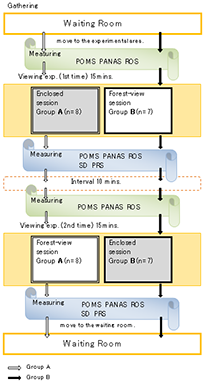** Progress in Earth and Planetary Science is the official journal of the Japan Geoscience Union, published in collaboration with its 51 society members.
** Progress in Earth and Planetary Science is partly financially supported by a Grant-in-Aid for Publication of Scientific Research Results to enhance dissemination of information of scientific research.
Gallery View of PEPS Articles
Research
Human geosciences
201706201706
The effect of slight thinning of managed coniferous forest on landscape appreciation and psychological restoration
Takayama N, Saito H, Fujiwara A, Horiuchi M
Landscape appreciation, Psychological restoration, Forest therapy, Recreational use, Thinning, Forest management
View of the study area.
Experimental procedure. The same experimental procedure was used in the May (unthinned) and October (thinned) experiments. Only the results of the forest- view session were used in the analysis (for both May and October); the data from the enclosed sessions were not analyzed.
We investigated the influence of slight thinning (percentage of woods: 16.6%, basal area: 9.3%) on landscape appreciation and the psychological restorative effect of an on-site setting by exposing respondents to an ordinarily managed coniferous woodland. The experiments were conducted in an experimental plot in the same coniferous woodland in May (unthinned) and October 2013 (thinned). The respondents were the same 15 individuals for both experiments. Respondents were individually exposed to the enclosed plot and the forest-view plot within the same tent for 15 min. In both sessions, respondents were required to answer three questionnaires measuring their mood (Profile of Mood States), emotion (Positive and Negative Affect Schedule), and feeling of restoration (Restorative Outcome Scale) to investigate the psychological restorative effect before and after the experiment. They completed two other questionnaires measuring appreciation for the environment (Semantic Differential) and the restorative properties of the environment (Perceived Restorativeness Scale) following the experiments. We first analyzed the difference in landscape appreciation between the unthinned and thinned conditions. We did not find any statistical difference in appreciation for the environment (Semantic Differential) or the restorative properties of the environment (Perceived Restorativeness Scale); rather, we found that weather conditions had a primary influence on landscape appreciation. With respect to the psychological restorative effect, a two-way repeated analysis of valiance (ANOVA) revealed significant main effects for a selection of indices, depending on the presence or absence of thinning. However, multiple comparison analyses revealed that these effects seemed to be due to the difference in the experimental experience rather than the presence or absence of thinning. In conclusion, the effect of the slight thinning of the managed coniferous forest was too weak to be reflected in the respondents’ landscape appreciation or to exert a psychological restorative effect. Therefore, planners should consider stronger thinning as it is unlikely to result in serious damage to users’ appreciation and may increase their landscape appreciation of coniferous woodland and enhance its psychological restorative effect.







